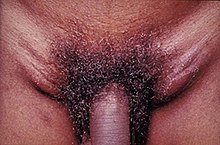User:Mr. Ibrahem/Lymphogranuloma venereum
| Lymphogranuloma venereum | |
|---|---|
| Other names | Climatic bubo,[1] Durand–Nicolas–Favre disease,[1] Poradenitis inguinale,[1] Lymphogranuloma inguinale, Strumous bubo[1] |
 | |
| Lymphogranuloma venereum in a young adult who experienced acute onset of tender, enlarged lymph nodes in both groins. | |
| Specialty | Infectious disease |
| Symptoms | Genital ulcer, large lymph nodes in the groin[2] |
| Complications | Fistulae, anal stricture[3] |
| Usual onset | 3 to 12 days post exposure[3] |
| Causes | Certain types of Chlamydia trachomatis[2] |
| Risk factors | Men who have sex with men, HIV/AIDS[3] |
| Diagnostic method | Culture, PCR[2] |
| Differential diagnosis | Herpes, syphilis, chancroid, granuloma inguinale, HIV/AIDS[3] |
| Treatment | Doxycycline, erythromycin[2] |
| Prognosis | Fair if treated[3] |
| Frequency | Uncommon[3] |
Lymphogranuloma venereum (LGV) is a sexually transmitted infection caused by certain types of Chlamydia trachomatis.[3] Symptoms may include a small painless genital ulcer and large lymph nodes in the groin on one side.[2][3] Rectal exposure can result in anal pain and discharge.[2] Onset is typically 3 to 12 days after exposure.[3] Complications may include fistulae or anal stricture.[3]
The disease is caused by the serovars L1, L2, and L3 of Chlamydia trachomatis.[2] It is spread by sex, including vaginal, oral, and anal sex.[3] Risk factors include men who have sex with men and HIV/AIDS.[3] The infection primarily involves the lymphatic system.[3] Diagnosis is suspected based on symptoms and confirmed by testing the site of infection by culture or PCR.[2]
The recommended treatment is with 3 weeks of doxycycline; with erythromycin as an alternative.[2] Incision and drainage of large lymph nodes may be required.[2] Sexual contacts within the last 60 days should also be tested and treated.[2] With treatment outcomes are fair.[3]
Lymphogranuloma venereum is uncommon; though is more common in tropical areas of the world.[3] It most commonly occurs in those between the ages of 15 and 40.[3] While it likely occurs equally in both sexes, males are more commonly diagnosed.[3] It was rare in developed nations before 2003, though a number of outbreaks have occurred in Europe and the USA since than.[4] The disease was first described by Wallace in 1833 and again by Durand, Nicolas, and Favre in 1913.[5][6]
References[edit]
- ^ a b c d Rapini, Ronald P.; Bolognia, Jean L.; Jorizzo, Joseph L. (2007). Dermatology: 2-Volume Set. St. Louis: Mosby. ISBN 978-1-4160-2999-1.
- ^ a b c d e f g h i j k "Lymphogranuloma Venereum (LGV) - 2015 STD Treatment Guidelines". www.cdc.gov. 2019-01-11. Retrieved 24 May 2021.
- ^ a b c d e f g h i j k l m n o p q Rawla, P; Thandra, KC; Limaiem, F (January 2021). "Lymphogranuloma Venereum". PMID 30726047.
{{cite journal}}: Cite journal requires|journal=(help) - ^ Richardson D; Goldmeier D (January 2007). "Lymphogranuloma venereum: an emerging cause of proctitis in men who have sex with men". International Journal of STD & AIDS. 18 (1): 11–4, quiz 15. doi:10.1258/095646207779949916. PMID 17326855. S2CID 36269503.
- ^ Parish, Lawrence C.; Gschnait, Friedrich (2012-12-06). Sexually Transmitted Diseases: A Guide for Clinicians. Springer Science & Business Media. p. 90. ISBN 978-1-4612-3528-6.
- ^ Durand N.J.; Nicolas J.; Favre M. (January 1913). "Lymphogranulomatose inguinale subaiguë d'origine génitale probable, peut-être vénérienne". Bulletin de la Société des Médecins des Hôpitaux de Paris. 35: 274–288.
